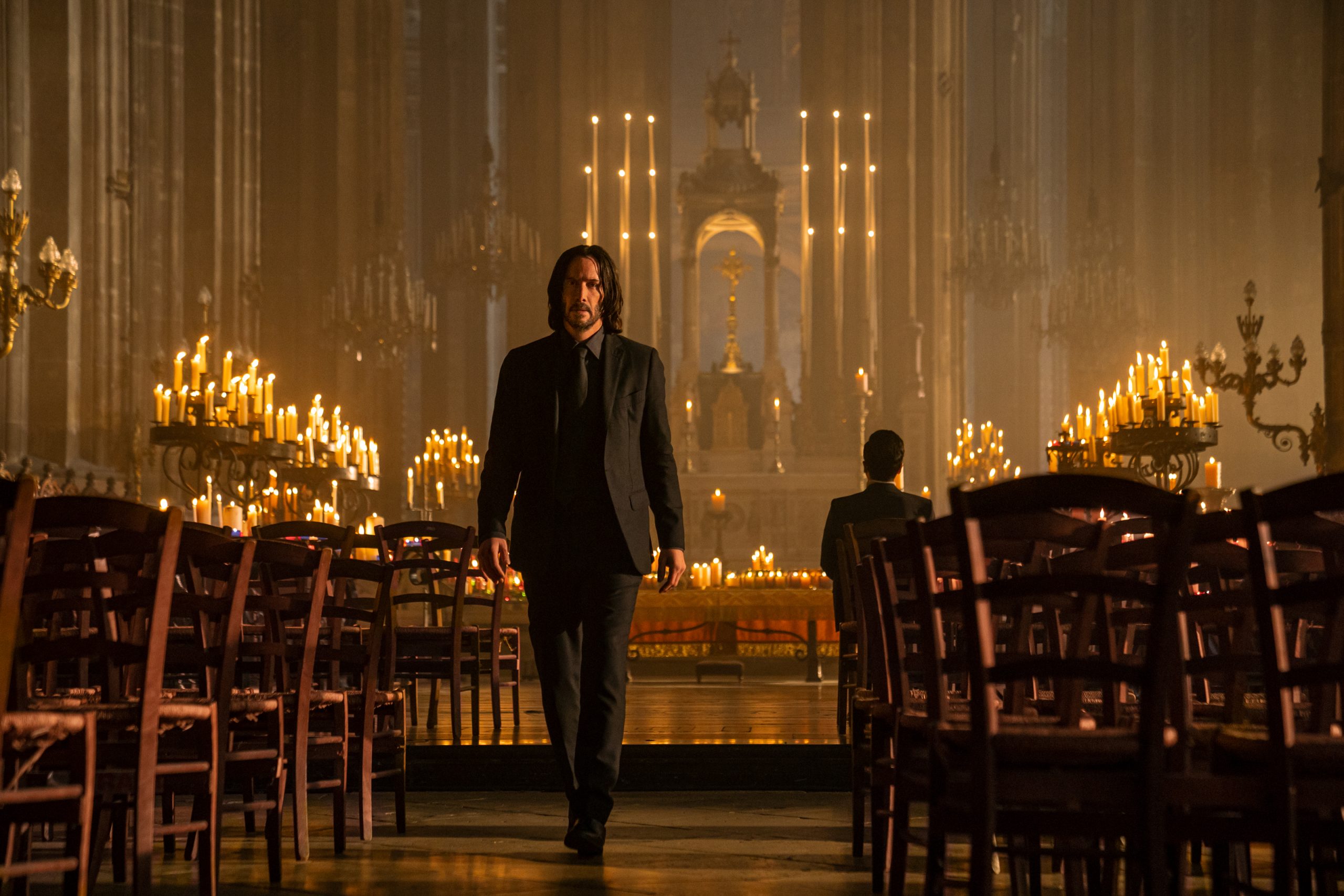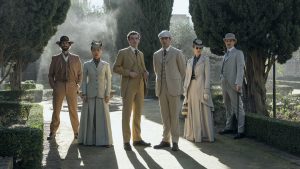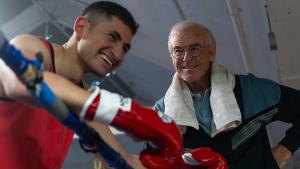
John Wick: Chapter 4 (2023)
No way back, one way out.
Five stars.
I am going to spoil the living hell out of John Wick: Chapter 4 in this review, but that five-star score tells you all you need to know. Go with God.
In the end, it’s all about death.
Most action movies are, really. The threat of death — or the implied threat of death — is the fuel that powers the action engine, even though we’re complicit with the films themselves in pretending the threat is real. You never really think that Ethan Hunt or Dom Toretto or John Rambo is going to buy the farm, but for the duration of a movie, you can fool yourself into believing they might — it’s that whole suspension of disbelief thing.
It’s pretty rare for the threat to be real, for the roulette ball the fall on the 00, for the dice to come up snake eyes, for the implicit to become explicit. But it does happen. No Time to Die (2021). Logan (2017). John Wick: Chapter 4.
John Wick, the black-suited, melancholy murder machine played to perfection by Keanu Reeves since 2014, dies at the climax of his latest outing, succumbing to his wounds after killing the villain du jour, the Marquis Vincent de Gramont (Bill Skarsgård) in a duel. Action fans will note that the weapons used are Thompson Center Arms Contenders, the same precision pistols used by Philip Kwok in Hard Boiled (1992) and Lance Henriksen in Hard Target (1993), both directed by John Woo. The Wick flicks have never been shy about their influences, happily winking at the audience members who are primed to pick up on these little nods and references.
Woo’s oeuvre gets another look-in when the blind assassin Caine (Donnie Yen, a brilliant addition) and Wick snatch a moment of peace in a candlelit church before heading out to try and kill each other. Caine pressganged into hunting Wick by a threat to his daughter, carries her portrait in a locket, an echo of Colonel Mortimer’s watch in For a Few Dollars More (1965). The relentless third act, an extended run ‘n’ gun that is one of the most audacious and ambitious action sequences ever committed to film, is soundtracked by a radio DJ who guides the inevitable army of assassins and mooks toward our hero with coded messages and on-point needle drops, a clear nod to Walter Hill’s The Warriors (1979). Action legend Scott Adkins, who plays loathsome German crime boss Killa, turns up in a fat suit and a purple suit that salutes Sammo Hung in SPL: Sha Po Lang (2005). Early on, Keanu’s old Matrix mate, Laurence Fishburne, here playing Wick’s ally, The Bowery King, gets to replicate the famous edit from Lawrence of Arabia (1962), blowing out a lit match as we cut to John on horseback in the desert, tidying up (well, blowing away) a few loose ends before the proper narrative action of the film commences.
It’s nods and references all the way down, is what I’m saying, and the problem with this kind of post-modern approach — which I enjoy, don’t fret — is that you can easily lose track, as a creator, of the really essential elements — character, motivation, need — as you attempt to service those viewers who live deep in the knowledge economy of fandom. Director Chad Stahelski and screenwriters Shay Hatten, Army of the Dead (2021), and Michael Finch, Predators (2010), do not make that mistake here. Every element, written or shot, lifted or original, is carefully considered. There’s such a variety of action, so much controlled chaos on screen, that you could be forgiven for thinking, at first taste at least, that they just threw everything against the wall to see what sticks, but that’s simply not true. John Wick: Chapter 4 is not just the magnum opus of the series, it actually corrects a problem that the series has had for a while, a question we haven’t had an answer for over the last couple of films.
What does John Wick want?
Now, in John Wick, that’s pretty clear: after Russian mob prince Iosef Tarasov (Alfie Allen) steals his ’69 Mustang and has his pet mook kill Daisy, the cute beagle puppy given to him by his beloved late wife, Helen (Bridget Moynahan), the ex-assassin wants to reclaim the former and avenge the latter—pretty straightforward stuff.
Since then, however, John’s been pretty reactive. He was drawn into the events of John Wick: Chapter 2 thanks to a Very Big Favor (a “marker” in the parlance of the Wikiverse) to Italian Camorra boss Santino D’Antonio (Riccardo Scamarcio), and all of John Wick: Chapter 3 – Parabellum involves him still dealing with the fallout. We see him maneuver and cut various deals (and people) in order to extricate himself from the shadowy world of hired killers ruled over by the mysterious High Table, but it’s hard to say what his victory condition is. What does a normal life look like for John Wick? Based on the glimpses we got in the first film, it doesn’t look like much fun.
I don’t think it’s a big stretch to say that John Wick has a death wish.
This runs counter to the character’s stated aims — he’s said he wants to stay on this side of the grave to keep the memory of his wife alive, but people will lie about their motivations, folks, even to themselves. When I look at John Wick, I see a man caught between a sincere desire for death and his own ingrained and well-tempered survival instincts. He’s never going to stick a gun in his mouth, but conversely, it’s hard to get killed in battle when you’re the world’s greatest assassin. That is the character’s central conundrum. If nothing else, it goes some way to explaining why the death of a dog has led to four movies’ worth of absolute carnage.
Death imagery abounds in John Wick: Chapter 4. It’s worth noting that Lawrence of Arabia begins with the death of its protagonist; Wick 4 climaxes with the same. In a key scene, Wick plays poker against Scott Adkins’ Killa, drawing a dead man’s hand. In the same scene, the shadow of a ceiling fan seems to decapitate Wick over and over. The signs and portents — and this is a series that loves signs and portents, ancient codes, and purple pageantry — are all there.
The other major theme running through the series, particularly this fourth installment, is the notion of family. Our hero is, of course, still torn up over Helen’s death, and though we only get the briefest insight into their relationship, it’s canonical that she’s the reason he gave up such an illustrious career in body-dropping. Donnie Yen’s Caine is stirred to action by a threat against his daughter. When John takes shelter at the Osaka branch of The Continental, he finds the manager, his old friend Shimazu Koji (Hiroyuki Sanada), has a daughter, Akira (Rina Sawayama), who acts as his concierge — and while I remember, the battle that takes place there draws imagery from another Akira Kurosawa, specifically his adaptation of Macbeth, Throne of Blood (1957), a film all about doom and destiny.
And then there’s Shamier Anderson’s Nobody, AKA The Tracker, a street-level assassin with his own agenda who vacillates between hunting Wick and protecting him from others who want to punch his ticket. He’s a man of mystery, and while it’s never explicitly stated, my money would be on him being connected to The Bowery King: his costume is roughly analogous to Fishburne’s, which is thin evidence, I’ll admit, but in the symbolism-laden poker scene, he draws a royal flush — is he The Bowery Prince?”
It makes thematic and tonal sense — the world of the High Table is a dynastic one, and our Big Bad this outing is a Marquis — the scion of a noble family. But he uses his position and implied familial clout solely for his own advantage. Notions like loyalty and just retribution are alien to him. His lineage is a weapon to be deployed, his family a tool, not an obligation.
All this is subtext, theme, mood, symbolism, while the action of the narrative plays out in, well, action. And the action is superb; Stahelski and action design company 87eleven are firing on all cylinders here, and his background as a stuntman and fight choreographer serve him incredibly well. The care with which each fight sequence is handled, coupled with the sheer audacity and scale of the violence, is remarkable — I can’t think of another film in recent memory that hits such heights in pure action — Mad Max: Fury Road (2015) was a while ago now. It’s hard to pick a favorite sequence — the Osaka Continental battle, which blends classic Hong Kong martial arts trappings with yakuza movie style, invoking Seijun Suzuki? The nightclub dust-up against Killa? The insane chase/fight/pile-up around the Arc de Triomphe? The Sisyphean charge up the stairs of Sacré-Cœur? All bangers — each could be the climax of any other movie. I actually don’t want to spill too much ink on the action, perversely enough, as it’s been the focus of many other reviews, but I can’t think of another filmmaker right now who is operating at this level in the action sphere.
And as we follow that action beat by beat, we’re led deeper into the dark demimonde that Wick had left behind when we first met him and in which he’s been mired ever since. The John Wick series left mere “reality” behind long ago; while the first film paid lip service to some kind of baseline plausibility, as the Chapters have piled up, the connection to the mundane has grown ever more tenuous. The High Table and its assassins operate parallel and apart, shielded from normie eyes by … heck, straight-up movie magic, really — the Rule of Cool. Maybe that’s just artistic license to enable even more outré stunts and fights, and maybe it’s a metaphor for Wick’s descent into what is essentially the afterlife (and there’s a good article on the notion of these films being a portal fantasy right here). In effect, it’s both, and cinematographer Dan Laustsen and production designer Kevin Kavanaugh work wonders evoking this slick neon hell, all garish reds, and yellows against the blackest blacks. The usual wonderful array of cult character actors and action legends have been assembled to portray the various denizens of this world. Ian McShane is back as the cooly droll Winston, manager of the New York continental, and the much-missed Lance Reddick returns as his concierge, Charon. Plus, we get newcomer to the franchise Clancy Brown, Starship Troopers (1997), bringing suitable gravitas to the role of The Harbinger, yet another of the High Table’s stable of psychopomps.
A psychopomp, of course, is an entity that guides the newly dead to the afterlife (see: Crow, The). Sitting back and looking at the overall arc of the Wick flicks, I think I’m using it appropriately here. John Wick is dead; his death, and his yearning for it, are the whole point. Stories need to end (dear God, we need to relearn that lesson as a culture), and John Wick’s story ends in the only way it could. Certainly, we never see what happens to his body, but we do see his headstone, right next to Helen’s, with the epitaph he requested. Certainly, there are spin-offs already on the way. Certainly, the economic drivers behind franchise filmmaking are in play, and I could have happily watched Keanu kill guys by the busload for another handful of movies were it not for how this one played out. We got the only possible ending for this character, because the alternative is to run out the string indefinitely, and then John Wick becomes just an action figure being bashed against other toys, the violence becomes bombastic and joyless, and the whole less than the sum of its parts.
Instead, we got the best of the bunch, a rare trick. Late-in-the-series masterpieces are vanishingly scarce, but mentioning John Wick: Chapter 4 in the same breath as Fury Road and The Good, the Bad and the Ugly (1966) feels right. If it were just the best action movie of the year, that would be enough. But it has purpose and depth. It has built on what has preceded it and finished up exactly where it should. I’ll show up for more excursions into the world of the High Table, have no doubt. But I sincerely hope this is the last we’ve seen of John Wick.
Baba Yaga is dead. Long live Baba Yaga.
5 / 5 – Don’t Miss!



